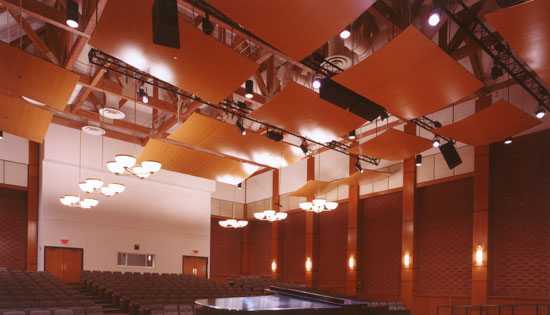Noise Control and Room Acoustics in Building Design
Learning Objectives:
- Summarize the basic principles, terminology and measurement methods for sound and vibration.
- Evaluate and select effective sound control building assemblies and finish materials according to design goals.
- Discuss the role of sound control performance criteria in wall, ceiling and floor framing design.
- Explain the methods and reasons for controlling sound reflections and reverberation within a room.
- Identify how sound control building systems can contribute to LEED® points.
Credits:
In contrast to patrons of super-loud restaurants who are oblivious of the fact that 90-plus decibels of sound can cause permanent damage to hearing, occupants of modern buildings are very much aware of noise, so much so, that their complaints about airborne and impact noise are a major source of building dissatisfaction.
Acoustics are increasingly recognized as an important feature of building design. Already playing a significant role in LEED® school construction, acoustics are contributing to LEED points in other types of construction. Given the number of projects that require special attention to sound control from concert halls to offices, plus the fact that conventional construction of floors, walls, and ceilings is often inadequate for controlling unwanted sound, design professionals benefit from knowledge of the principles of sound, plus methods for its control.
Measuring sound
Sound travels in waves. In solid building materials, it progresses as vibration. Building materials, such as stud walls, glass windows and concrete floors vibrate at a variety of frequencies when excited by sound or vibration. What we hear are fluctuations in air pressure produced by the vibrating surfaces.
Decibel (dB).
The decibel is commonly used in acoustics to quantify sound levels relative to a 0 dB reference, the typical threshold of perception of an average human
Hertz (Hz).
Sound frequency is measured in Hertz (Hz), cycles per second. The frequency of the fluctuation in pressure determines the pitch. Most sounds are a combination of many frequencies. The human voice or a diesel generator produce sound across many frequencies. An example of a single frequency is the striking of a piano key producing a single note. The 1st (lowest) key is 27 Hz. The 88th key is 4186 Hz.
 |
Wood veneer reflectors manage acoustics at Susquehanna University, Selingsgrove, PA. Photo provided by Kinetics Noise Control |









